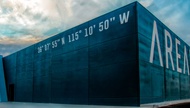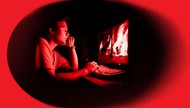Dusk is falling outside the Alien Research Center, and I’m ready to go home. But Mikayla, our photographer, wants to capture some final shots of the metal alien while the light is good. The sun is flat on the horizon, turning the desert, the highway, the alien and everything else gold. The pros call this moment “magic hour.” I shuffle around the empty lot and snap a few phone pics of a street sign that warns: Open Range Next 110 Miles.
From out of nowhere, a rushing engine and flying dirt. Could it be a UFO? Nope. It’s a jalopy, nearly hitting me. A young man and his father have driven all the way from Eau Claire, Wisconsin, to explore the interplanetary hot spot that surrounds state Route 375, aka the Extraterrestrial Highway. They’ve already visited the gate to Area 51, but they’re too late for the Alien Research Center. The gift shop is closed.
Meeting an extraterrestrial would be the coolest thing ever, the son, Jeremy Richter, tells me. He spins intricate histories of aliens, and I wonder aloud what he’ll do if he actually meets one.
His answer? A question: “What do you think about our species? In my opinion, our species is half idiotic and half insane.”
What is it about humanity and our insatiable need to be judged? Thousands of years of advancement and we still desire some Egyptian god—or Ancient Alien—to weigh our souls against a feather.
In Rachel, Nevada, polite European tourists have mostly replaced the true believers. This town is famous for interstellar travel, yet it doesn’t even have a gas station. But it does have the Little A’Le’Inn, which serves surprisingly delicious “World Famous Alien Burgers.” Inside, the waitress wears flying saucer earrings and a branded T-shirt. Also, the wall of old UFO photos has been encased in plexiglass, and the owner has grown suspicious of camera-wielding journalists.
There, Mikayla and I buy enamel souvenir pins and a 33-cent map of Area 51. We use the latter to find the famous “black mailbox,” which an annoyed local rancher constructed to corral all the letters people sent to aliens. It has come and gone and even changed color over the years. Right now, it’s located at the dirt-road turnoff to Area 51.
It’s also surrounded by an ad hoc collection of trinkets. I look and see the future: One day, after the robots revolt, the zombies attack and the few human survivors regroup into sad little bands that scour a scorched and despoiled Earth, this will be what passes for a religious temple. Even now, it feels holier than Parisian cathedrals. The items could be mistaken for the flotsam and jetsam of a single-use society, except for the thoughtful way it has all been arranged: painted rocks, a Star Wars-themed sunshade, a Hawaiian lei, mason jar shrines, business cards, foil food wrappers, water bottles, a pink glowstick, a brunette hairdresser’s mannequin ... and, above it all, an American flag taped to a broken lawn chair.
The black mailbox is stuffed, and the letters are all dated within the past few weeks. They’re written on whatever scrap people had with them: valet parking tickets, a Utah church comment card and a Styrofoam cup. Most are ironic or funny or fishing for social media likes. But Mary Staunton’s letter to “E.T.” sticks with me: In neat script, the Irish woman explains how her late husband had wanted to meet an alien: “He always said that we have enough room in our garden for a ship to land. Maybe he’s with you now. I still miss him so much.”
The scene outside the Little A’Le’Inn is equal parts Mayberry and Twilight Zone. Two middle-aged tourists from the Midwest relax out front, enjoying the shade of a rare tree. Begrudgingly they admit their fascination with UFOs, like it’s an embarrassing medical condition. They have a healthy sense of skepticism, but still, they’ve seen some freaky stuff. To their credit, invisible planes buzz overhead—circling and circling, like motorcycles in a cage. Also, right on the side of the road, there’s a big government testing device that tracks the amount of nuclear contaminants in the air. It’s higher here than in Vegas, but Vegas isn’t at zero radiation, either.
These men understand the ambient creepiness but also stand outside it. Like the way we enjoy Vegas kitsch: It’s that double appreciation where you get the joke but also fall for it at the same time. Just as Mikayla and I are searchers, even though we pretend not to be.
Once I start looking for them, I see aliens everywhere. A Hoover Dam gift shop called the Flying Saucer stocks a collection of used and rare books and DVDs about aliens. A green figurine rides a model train at the Railroad Museum in Boulder City. A bunch of cute, alien-themed school supplies are on clearance at the local big box. Bumper stickers, tattoos, emoji and trendy hipster patches. Turns out Alien Tequila is owned by George Harris, who also owns the Alien Research Center. He’s planning to build a museum in the back.
If what we seek can be found, Mikayla and I discover it in the array of alien-themed gift shops and jerky stands scattered around our desert landscapes. Here, decades of human ambition, fears and scientific discoveries have been distilled to a shelf of refrigerator magnets and bouncy balls. I’m sincerely inspired when I see the vast selection of memorabilia. Together it tells the story of who we are and who we want to be: from the optimism of Star Trek’s Prime Directive to the deadpan cool of Men in Black to the suspicion and distrust at the heart of The X-Files. Are aliens as ubiquitous in older places, where trees and skyscrapers crowd out potential UFO landing spots? Or just in the desert Southwest, where the Wild West serves as a runway to the Final Frontier?





